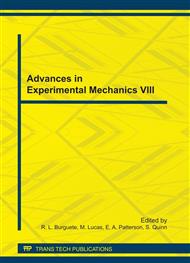p.63
p.69
p.75
p.81
p.87
p.93
p.99
p.105
p.111
Damage Observation and Analysis of a Rock Brazilian Disc Using High-Speed DIC Method
Abstract:
Observation of damage evolution is of great importance to the understanding of the failure process of rock materials. High-speed DIC system is constructed and used to observe the strain field evolution of the granodiorite disc in Brazilian test. The strain fields at different load levels are analyzed based on the stain abnormality indicator (SAI) which is the ratio of the strain measured in experiment to the strain from theoretical solution in an isotropy and elastic model. SAI could be used to indicate the damage in the specimen. The process of damage and failure of the specimen in Brazilian disc test is quantitatively analyzed and deeply discussed according to the strain fields and the statistics of SAI. Experimental results in this paper show that the failure process of the disc specimen in Brazilian test is not simple crack propagation under tensile load, but a complicated damage evolution procedure.
Info:
Periodical:
Pages:
87-92
Citation:
Online since:
August 2011
Authors:
Keywords:
Price:
Сopyright:
© 2011 Trans Tech Publications Ltd. All Rights Reserved
Share:
Citation:


